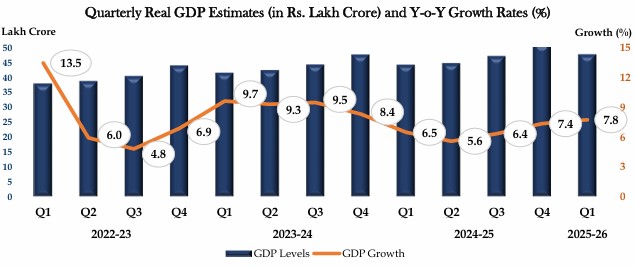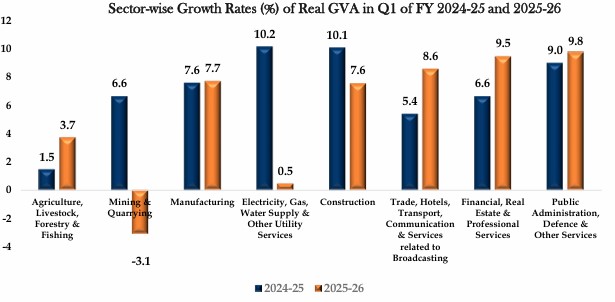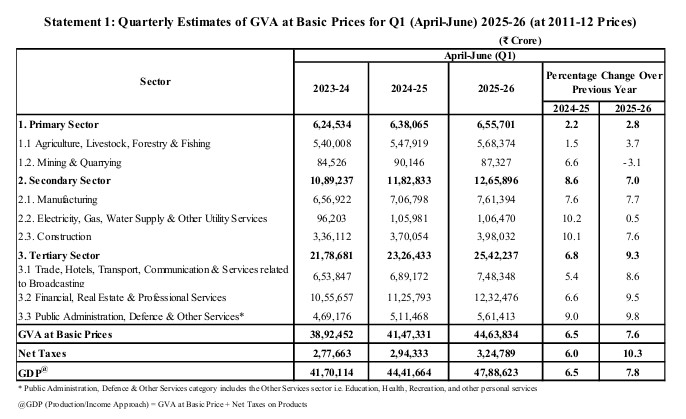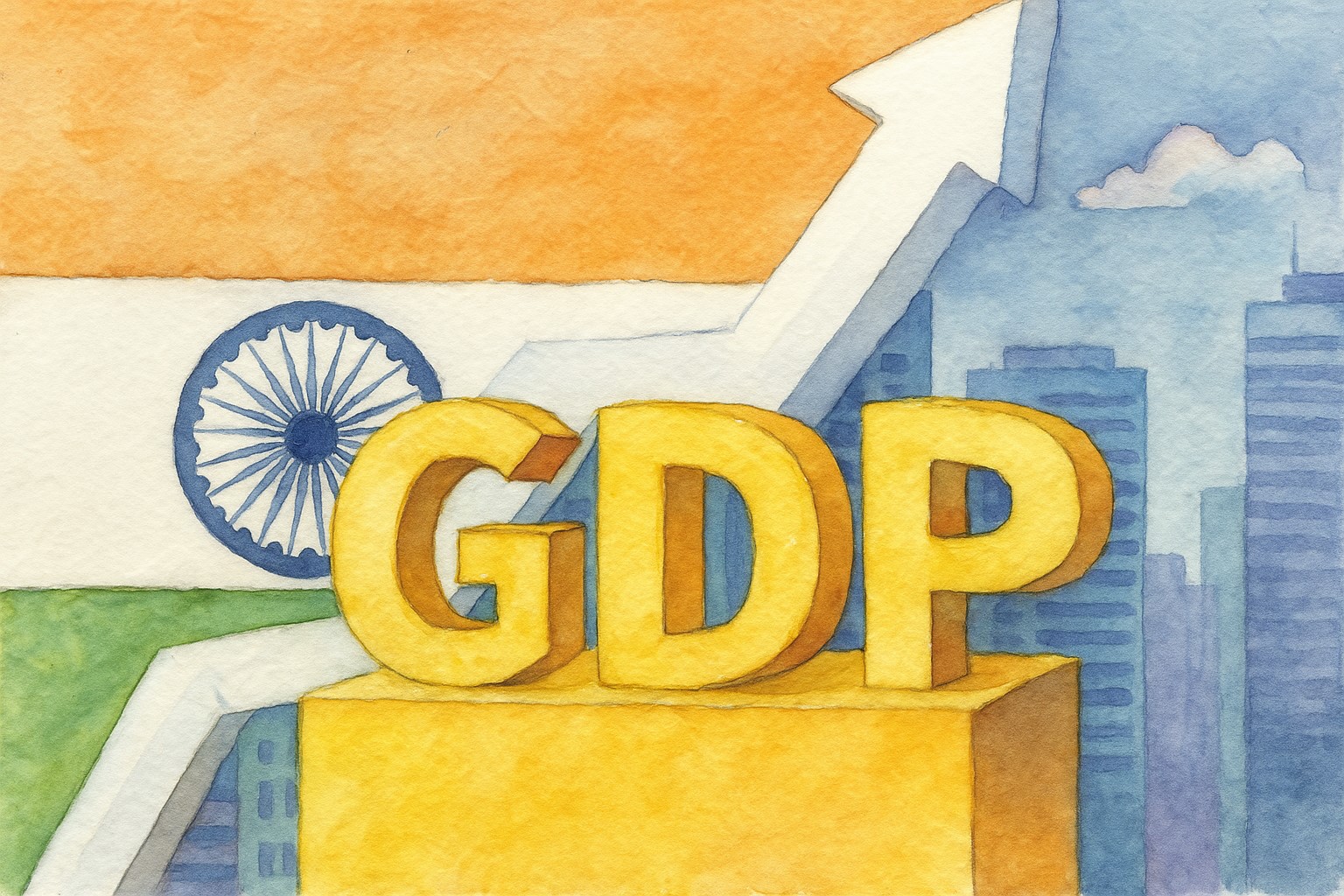Earlier, we had discussed one of the economic indicators through which we can track the economy—how much the economy is producing and the performance of various industrial sectors of the Indian economy—i.e., the IIP.
Now, today we will discuss the total value of the goods and services produced in a country during a particular period compared to the previous quarter. This helps us understand whether the economy is really growing. We will also discuss the latest data released by the MoSPI on GDP.
Before diving into the data released by the MoSPI, we need to understand what GDP actually is and which factors contribute to it.
Let’s dive into this:
What is GDP?
So, Basically GDP Full form is Gross Domestic Product What this tell us to is the total value of the Goods & Services produced in a country at a Particular Period. It Includes all private and public consumption, government Spending, Investments, Export minus Import. The data released Every Quarter after the Quarter Ends by the Ministry of Statistics and Program Implementation.
While reading GDP data, you will often find two types of GDP which may confused you:
Nominal GDP
Nominal Gross Domestic Demand is the value of Goods & Services in a country at a specific period using Current Market Prices without removing the effect of price increase (inflation).
Example – If India produces goods & services worth 2 Crore in 2024, and price rises by 5% in 2025 then even if the actual output stays the same, the nominal GDP in 2025 will appear to be ₹2.1 lakh crore. That growth is due to inflation, not increased production.
Real GDP
Real Gross Domestic Product is the total value of Goods & Services produced in a country after removing the effect of inflation. It shows how much the economy is actually growing in terms of production, not just because of price Increases.
Example – If India produces goods and services worth ₹2 crore in 2024, and in 2025, prices rise by 5%, but the actual production stays the same, then the Real GDP in 2025 will still be ₹2 crore. This is because Real GDP removes the effect of price increase and shows the actual growth in production — which, in this case, is zero.
How’s the Indian economy doing?

Recently, the Ministry of Statistics and Programme Implementation (MOSPI) released the latest GDP data, which shows that the Indian economy is experiencing robust growth.
In the first quarter of the financial year 2025–26 (April to June 2025), the economy grew at a rate of 7.8%, compared to 6.5% in the previous quarter.
Nominal GDP Shows the growth of 8.8% in Q1 FY26 (April 2025 – June 2025) as comparison to 7.6% in Q1 FY 25. As of June 2025, India’s nominal GDP has reached approximately $3.78 trillion. This strong growth has been driven by factors such as rising domestic demand, increasing employment, higher private consumption, and supportive government policies and reforms.
This Expectation leads to touch $7.3 trillion of GDP & is on the path to become the third largest economy by FY 30.
How the Indian Sectors are Performing?
MOPSI has Divided the Whole Economy into three Sector i.e. Primary, Secondary, and Tertiary. The Primary Sector includes activities like agriculture, fishing, and mining that involve natural resources. The Secondary Sector involves manufacturing and construction, where raw materials are turned into goods. The Tertiary Sector covers all the services such as banking, education, and transport etc. Lets discuss how they perform.

1. Tertiary Sector:
a) Growth: 9.3%
b) Strong performance in:
1) Trade, hotels, transport, communication: 8.6%
2) Financial and real estate services: 9.5%
3) Public administration and defence: 9.8%
c) Largest contributor to GDP growth in Q1 FY26.
2. Secondary Sector:
a) Growth: 7.7%, slightly higher than Q1 FY25.
b) Construction: 7.6%, slightly below last year’s performance.
c) Overall secondary sector (including utilities): 7.0%, down from 8.6% in Q1 FY25.
3. Primary Sector:
a) Growth: 3.7%, improved from 1.5% in Q1 FY25.
b) Mining Sector: Contracted by -3.1%, after a growth of 6.6% in Q1 FY25.
c) Total primary sector growth: 2.8%, slightly up from 2.2% last year.

The above table shows us the contribution of a particular sector or industry to the overall economy as compared to previous Years at the same quarter. The numbers show how much each part of the economy is producing compared to last year. This helps understand which parts are growing fast and which are slowing down.
Conclusion
Overall, the latest results are positive, and the economy is expected to continue performing well in the future, maintaining a steady and confident growth trajectory. According to experts, the GDP growth rate for FY 2025–26 is projected to be between 6.3% and 6.8%, driven by strong domestic demand, GST rate cuts, and supportive government initiatives. If this pace continues, India is well on track to achieve its target of becoming a $7.3 trillion economy by FY 2030, potentially emerging as the third-largest economy in the world. However, some impact on growth may arise due to tariffs imposed by the United States & the outlooks remain optimistic, some Uncertainties Still persist.
